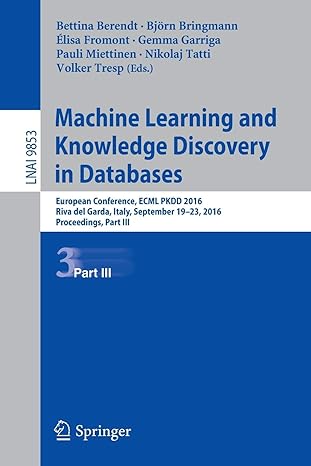Question
For this problem you will implement several agent types in a variant of the vacuum world described in our text/lecture. You are welcome to write
For this problem you will implement several agent types in a variant of the vacuum world described in our text/lecture. You are welcome to write code in any language you prefer (you need not turn the code in with your homework) your implementation can have graphics, but again, this is not required. Consider a 3x3 grid for the vacuum world environment. The agent can go up, down, left right, suck or do nothing. Randomize the starting location of the robot, the number of rooms with dirt piles (lets say in separate cases: 1, 3 and 5 piles initially, respectively), as well as the locations of the dirt piles. Record and compare the performance score (e.g. total number of moves to clean the environment you are free to make up your own performance score/evaluation standard). You should cap the number of steps in your simulations reasonably to avoid infinite loops. Report results for the following types of agents: (i) A simple reflex agent (in this case define a rule table based on the location/dirt present just as in the book); in this case you can just make up a rule for where the robot moves next, according to its current location. Please note that the where to move next rule is only based on the current percept and should be fixed by the rule table (which is to say we dont actively learn a movement strategy). (ii) A randomized agent (movement and suck/no suck are randomized). Describe explicitly how you randomize the agent. (iii) Apply murphys law with the same environment for a reflex agent. Murphys law: 25% of the time the suck action fails to clean the floor if it is dirty and deposits dirt onto the floor if the floor is clean; suppose also that the dirt sensor give the wrong answer 10% of the time. (iv) Apply murphys law conditions (as in iii) for a randomized agent. For your answer, write a short summary of your findings in no more than a few paragraphs. Please report/contrast your results for each agent and environment for parts (i)-(iv); in each case, report the average performance, in addition to the performance measure you used. So that the results are meaningful for comparison, run each agent for a fixed number of initial dirt piles (1, 3 and 5, respectively), with random initial locations for the piles and agent; report results for a reasonable number of trials in each case (e.g. 100 or so). Offer some insightful commentary. In summary: in the end, you should have comparative performance measures for each of the (4) agents, for cases of 1, 3 and 5 initial dirt piles (12 cases in all), respectively; run each experiment 100 or so times.
Step by Step Solution
There are 3 Steps involved in it
Step: 1

Get Instant Access to Expert-Tailored Solutions
See step-by-step solutions with expert insights and AI powered tools for academic success
Step: 2

Step: 3

Ace Your Homework with AI
Get the answers you need in no time with our AI-driven, step-by-step assistance
Get Started


